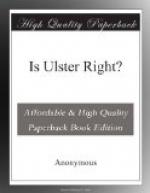The citizens of Dublin were naturally strongly against
the measure, thinking that it would injure the prestige
of the capital; as were also the proprietors of boroughs
and the legal members of the House; and soon after
the scheme had been proposed, several counties held
meetings and passed resolutions against it; but as
the year went on, when the details of the measure
had been more carefully considered, there was a general
change of feeling throughout the country. Lord
Cornwallis went on tours both north and south, through
both Protestant and Roman Catholic districts, everywhere
receiving addresses in favour of the Union from corporations,
grand juries, leading residents, and especially from
Roman Catholic bodies. And, if we may believe
Lord Cornwallis’s own letters, these addresses
were entirely spontaneous, and represented the real
feelings of the community. Before Parliament met
in March 1800, twenty-two counties had passed resolutions
in favour of the Union; and Lord Castlereagh was able
to say in the House that the great body of the landed
property of Ireland, and all the great commercial
towns except Dublin and Drogheda, were friendly to
the measure. The Opposition attempted to meet
this by presenting a number of petitions showing that
the people of Ireland were against it. Of the
fifty-four petitions presented, five were not against
the Union at all, but merely requests for compensation
in the event of its coming about; three were from
individuals or commercial firms; and eight were from
Dublin alone. The number therefore was much smaller
than appears at first sight. Besides obtaining
these petitions, the Opposition also collected a large
sum of money for the purchase of seats; in the circumstances
and according to the ideas of the time, I do not say
that they were in the least morally wrong in doing
so; but the fact takes away from the value of the
votes given; and it neutralizes anything that was
done by the Government in the same way—if
it can be proved that the Government so acted.
But as the Roman Catholics constituted three-fourths
of the population of Ireland, it is more important
to investigate what their feelings were than to scrutinize
the division lists of the House, if we wish to ascertain
what was really the wish of the nation. Fortunately
we have an opportunity of testing whether there is
any truth in the statement of O’Connell to which
I have already referred—that the Irish
Catholics did not assent to the Union. The evidence
shows conclusively that the Roman Catholic peerage,
episcopate, priesthood and laity all gave the movement
their hearty concurrence and co-operation. Lords
Kenmare and Fingall assured Lord Cornwallis that the
Catholics were in favour of a Union; the entire episcopate—that
is, the four archbishops and nineteen bishops, three
sees being vacant—expressed the same view
by their letters which are still extant or by resolutions
signed by them; for instance, the Archbishop of Tuam
wrote: “I have had an opportunity of acquiring




